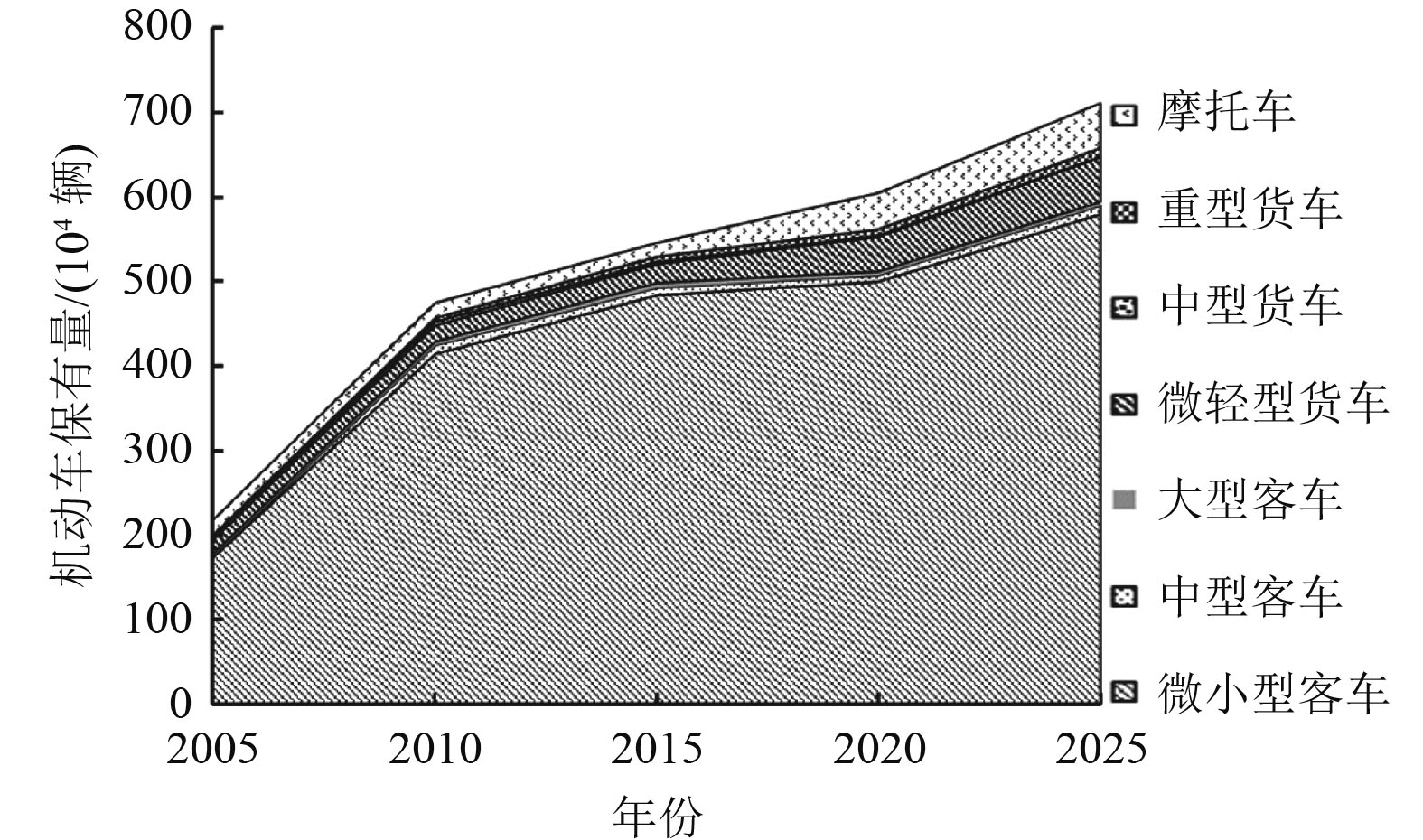Scenario analysis of motor vehicle emission trends and synergistic control in Beijing
-
摘要:
为了分析北京市长时间尺度的机动车尾气排放趋势,研究机动车排放大气污染物和温室气体的协同控制效应。应用COPERT 5模型构建2005—2020年北京市机动车污染物CO、NOx、VOCs、PM2.5和CO2、CH4、N2O的排放清单,以2020年为基准年,设置5种减排情景评估2025年各情景下的机动车污染物减排效果,并利用协同减排弹性系数法和坐标系法分别分析了大气污染物与温室气体的协同效应。结果表明:CO2排放增长趋势显著,相比2005年,2020年其排放增长率达到85.25%,而其他污染物相比2005年均呈下降趋势。不同控制情景下,北京市机动车大气污染物和温室气体排放量相比于基准情景(BAU)均具有减排效果,综合控制情景(RIS)减排效果最好。从协同减排弹性系数法和坐标系法分析结果看,不同控制情景下大气污染物和温室气体均具有协同效应,且RIS下协同效应最优。未来北京市应积极采取综合控制对策,兼顾统筹各种减排措施,为尽快实现降碳减污协同治理和绿色低碳经济社会转型奠定基础。
Abstract:In order to analyze the trends of motor vehicle emissions on the time scale of Beijing, the synergistic control effects of motor vehicle emissions of air pollutants and greenhouse gases were studied. COPERT 5 model was applied to construct the emission inventories of motor vehicle pollutants CO, NOx, VOCs, PM2.5 and greenhouse gases CO2, CH4 and N2O in Beijing from 2005 to 2020, and five emission reduction scenarios were set up to evaluate the emission reduction effects of motor vehicle pollutants under each scenario in 2025 with 2020 as the base year, and the synergistic emission reduction elasticity coefficient method and coordinate system method were applied to analyze the synergistic effects of air pollutants and greenhouse gases, respectively. The results showed that CO2 emissions increased significantly, with a growth rate of 85.25% in 2020 compared to 2005, while all the pollutants decreased compared to 2005. Under different control scenarios, the emissions of motor vehicle air pollutants and greenhouse gases in Beijing were reduced compared with the business-as-usual scenario (BAU), and the integrated control scenario (RIS) had the best emission reduction effect. From the results of the synergistic emission reduction elasticity coefficient method and coordinate system method, the synergistic effects of air pollutants and greenhouse gases under different control scenarios were observed, and the synergistic effects were optimal in the RIS scenario. In the future, Beijing should actively adopt comprehensive control measures and coordinate various emission reduction measures, laying the foundation for collaborative governance of pollution reduction and carbon reduction and green low-carbon economic and social transformation as soon as possible.
-
表 1 机动车排放情景设置
Table 1. Descriptions of motor vehicle emission control scenarios
控制对策 控制情景 情景描述 单一对策 基准情景(BAU) 保持当前北京市实行的控制措施和排放标准与基准年一致,不实施其他减排措施且机动车保有量遵循自然淘汰更新规律 淘汰高排放汽车(ESV) 依据《北京市“十三五”时期交通发展建设规划》,结合2020年国4排放标准车辆平均燃料消耗量和使用年限,到2025年基本淘汰国4及以下微小型汽油客车与轻型载货柴油车,根据车型占比,预计由32.9%国4以下微小型汽油客车和14.4%轻型载货柴油车淘汰更新为国6标准车辆 推广新能源汽车(NEV) 依据《北京市“十四五”时期交通发展建设规划》,结合《北京市推广应用新能源汽车管理办法》,设置从2020年新能源车占比为6.3%到2025年占比达到28.2%,全市新能源汽车保有量达到200万辆,其中新能源客车占比95%,新能源货车占比5% 发展公共交通
(DPT)依据《北京城市总体规划(2016—2035年)》,结合《北京市“十四五”时期交通发展建设规划》中提到的北京中心城区公共交通占机动化出行比例预期提高至62.3%,设置到2025年微小型客车、摩托车年均行驶里程相比基准情景分别降低15%和20% 综合对策 综合控制情景(RIS) 将所有控制措施进行结合,以考虑其综合减排的潜力 表 2 2025年北京市机动车大气污染物和温室气体排放量预测
Table 2. Prediction of emissions of air pollutants and GHGs from motor vehicles for the target year of 2025 in Beijing
t 年份 大气污染物排放量 温室气体排放量 CO NOx VOCs PM2.5 CO2 CH4 N2O 2020 62 018.3 51 882.2 13 683.5 2 306.4 21 449 371.5 1 405.8 218.9 2025 78 959.1 57 810.9 18 206.6 2 878.3 26 504 480.6 1 804.7 286.3 表 3 不同控制情景下温室气体对大气污染物的减排弹性系数
Table 3. Elasticity coefficient of GHG emission reduction on air pollutants under different control scenarios
控制对策 控制情景 $\mathrm{ELS}_{\left(\mathrm{CO}_2 \mathrm{e} / \mathrm{NO} x\right)} $ $\mathrm{ELS}_{\left(\mathrm{CO}_2 \mathrm{e} / \mathrm{PM}_{2.5} \right)} $ $\mathrm{ELS}_{\left(\mathrm{CO}_2 \mathrm{e} / \mathrm{VOCs} \right)} $ $\mathrm{ELS}_{\left(\mathrm{CO}_2 \mathrm{e} / \mathrm{CO} \right)} $ $\mathrm{ELS}_{\left(\mathrm{CO}_2 \mathrm{e} / \mathrm{AE} \right)}$ 单一对策 ESV 0.37 0.51 0.74 0.60 0.59 NEV 1.00 1.01 1.04 1.02 1.02 DPT 7.92 1.28 1.11 0.83 0.87 综合对策 RIS 0.87 0.91 1.00 0.92 0.92 -
[1] LI R, WU J J, LIU H, et al. Crowded urban traffic: co-evolution among land development, population, roads and vehicle ownership[J]. Nonlinear Dynamics,2019,95(4):2783-2795. doi: 10.1007/s11071-018-4722-z [2] 樊守彬.北京机动车尾气排放特征研究[J]. 环境科学与管理,2011,36(4):28-31. doi: 10.3969/j.issn.1673-1212.2011.04.008FAN S B. Tail-pipe emission characteristics from on-road vehicles in Beijing[J]. Environmental Science and Management,2011,36(4):28-31. doi: 10.3969/j.issn.1673-1212.2011.04.008 [3] 俞珊, 张双, 张增杰, 等.北京市“十四五”时期大气污染物与温室气体协同控制效果评估研究[J]. 环境科学学报,2022,42(6):499-508.YU S, ZHANG S, ZHANG Z J, et al. Assessment of co-control effects for air pollutants and greenhouse gases in Beijing during the 14th Five-Year Plan period[J]. Acta Scientiae Circumstantiae,2022,42(6):499-508. [4] 谭琦璐, 杨宏伟.京津冀交通控制温室气体和污染物的协同效应分析[J]. 中国能源,2017,39(4):25-31. doi: 10.3969/j.issn.1003-2355.2017.04.005TAN Q L, YANG H W. Co-benefit analysis of greenhouse gases and local air pollutants mitigation for transportation sector in Beijing-Tianjin-Hebei region[J]. Energy of China,2017,39(4):25-31. doi: 10.3969/j.issn.1003-2355.2017.04.005 [5] 唐伟, 郑思伟, 何平, 等.基于情景分析的杭州市机动车尾气排放控制协同效应研究[J]. 环境科学学报,2019,39(6):2033-2042.TANG W, ZHENG S W, HE P, et al. Study on the co-benefit of motor vehicle emission control based on scenario analysis in Hangzhou[J]. Acta Scientiae Circumstantiae,2019,39(6):2033-2042. [6] ALAM M S, HYDE B, DUFFY P, et al. Analysing the co-benefits of transport fleet and fuel policies in reducing PM2.5 and CO2 emissions[J]. Journal of Cleaner Production,2018,172:623-634. doi: 10.1016/j.jclepro.2017.10.169 [7] HUBOYO H S, SUTRISNO E, SUTRISNO A M, et al. Spatial distribution of conventional air pollutant and GHGs from land transportation in two developing cities and main co-benefit actions for reducing it[J]. E3S Web of Conferences,2018,31:09005. doi: 10.1051/e3sconf/20183109005 [8] THAMBIRAN T, et al. Air pollution and climate change co-benefit opportunities in the road transportation sector in Durban, South Africa[J]. Atmospheric Environment,2011,45(16):2683-2689. doi: 10.1016/j.atmosenv.2011.02.059 [9] JIAO J D, HUANG Y, LIAO C. Co-benefits of reducing CO2 and air pollutant emissions in the urban transport sector: a case of Guangzhou[J]. Energy for Sustainable Development,2020,59:131-143. doi: 10.1016/j.esd.2020.10.005 [10] 俞珊, 张双, 张增杰, 等. 北京市减污降碳协同控制情景模拟和效应评估[J/OL]. 环境科学. [2022-09-13]. doi: 10.13227/j.hjkx.202204344.YU S, ZHANG S, ZHANG Z J, et al. Scenario simulation and effect assessment of coordinated control of pollution and carbon reduction in Beijing[J/OL]. Environmental Science. [2022-09-13]. doi:10.13227/j.hjkx.202204344. [11] 李云燕, 宋伊迪.碳中和目标下的北京城市道路移动源CO2和大气污染物协同减排效应研究[J]. 中国环境管理,2021,13(3):113-120.LI Y Y, SONG Y D. Study on the synergetic emission reduction effect of CO2 and air pollutants from the mobile source of urban roads in Beijing under the target of carbon neutralization[J]. Chinese Journal of Environmental Management,2021,13(3):113-120. [12] 沈岩, 武彤冉, 闫静, 等.基于COPERT模型北京市机动车大气污染物和二氧化碳排放研究[J]. 环境工程技术学报,2021,11(6):1075-1082. doi: 10.12153/j.issn.1674-991X.20210289SHEN Y, WU T R, YAN J, et al. A study of motor vehicle air pollutant and carbon dioxide emissions in Beijing based on COPERT model[J]. Journal of Environmental Engineering and Technology,2021,11(6):1075-1082. doi: 10.12153/j.issn.1674-991X.20210289 [13] 王安, 杨雨, 杨锦伟.GPM(1, 1, m)模型及其在中国能源消费预测中的应用[J]. 数学的实践与认识,2021,51(2):104-112.WANG A, YANG Y, YANG J W. GPM(1, 1, m) model and its application in forecasting energy consumption of China[J]. Mathematics in Practice and Theory,2021,51(2):104-112. [14] 赵红梅.基于Gompertz曲线模型之上的中国千人汽车保有量中长期预测[J]. 工业技术经济,2012,31(7):7-23. doi: 10.3969/j.issn.1004-910X.2012.07.001ZHAO H M. The medium and long term forecast of China's vehicle stock per 1 000 person based on the Gompertz model[J]. Journal of Industrial Technological Economics,2012,31(7):7-23. doi: 10.3969/j.issn.1004-910X.2012.07.001 [15] 井玮罡, 董洁霜, 冯纪朋.基于灰色预测模型的中小城市机动车保有量预测及应用[J]. 物流科技,2015,38(8):40-43.JING W G, DONG J S, FENG J P. Forecast of the motor vehicle inventory of middle-sized and small cities based on the gray model and it's application[J]. Logistics Sci-Tech,2015,38(8):40-43. [16] 宋晓伟, 郝永佩, 朱晓东.基于情景分析的长三角城市群机动车污染排放控制研究[J]. 生态环境学报,2019,28(11):2245-2256.SONG X W, HAO Y P, ZHU X D. Research on vehicular pollutants emission control in the Yangtze River Delta urban agglomeration based on scenario analysis[J]. Ecology and Environmental Sciences,2019,28(11):2245-2256. [17] 程颖, 于雷, 王宏图, 等.基于PEMS的MOBILE与COPERT排放模型对比研究[J]. 交通运输系统工程与信息,2011,11(3):176-181.CHENG Y, YU L, WANG H T, et al. Comparative study of MOBILE and COPERT emission models based on PEMS[J]. Journal of Transportation Systems Engineering and Information Technology,2011,11(3):176-181. [18] 张兰怡, 胡喜生, 邱荣祖.机动车尾气污染物排放模型研究综述[J]. 世界科技研究与发展,2017,39(4):355-362.ZHANG L Y, HU X S, QIU R Z. A review of research on emission models of vehicle exhausts[J]. World Sci-Tech R & D,2017,39(4):355-362. [19] JIANG P Y, ZHONG X, LI L. On-road vehicle emission inventory and its spatio-temporal variations in North China Plain[J]. Environmental Pollution,2020,267:115639. doi: 10.1016/j.envpol.2020.115639 [20] CAI H, XIE S. Estimation of vehicular emission inventories in China from 1980 to 2005[J]. Atmospheric Environment,2007,41(39):8963-8979. doi: 10.1016/j.atmosenv.2007.08.019 [21] 张溪, 张一鸣, 孙建平, 等.2020年新冠肺炎疫情期间北京市道路运行特征研究[J]. 交通工程,2021,21(5):68-76.ZHANG X, ZHANG Y M, SUN J P, et al. Research on the characteristics of road operation in Beijing during COVID-19 in 2020[J]. Journal of Transportation Engineering,2021,21(5):68-76. [22] 郭继孚. 北京市交通发展年度报告[R]. 北京: 北京交通发展研究中心, 2021. [23] SUN S, ZHAO G, WANG T, et al. Past and future trends of vehicle emissions in Tianjin, China, from 2000 to 2030[J]. Atmospheric environment,2019,209:182-191. doi: 10.1016/j.atmosenv.2019.04.016 [24] 王凯, 樊守彬, 孙改红, 等.基于行驶里程的北京市延庆区机动车排放清单建立及特征分析[J]. 环境工程技术学报,2019,9(2):119-125. doi: 10.12153/j.issn.1674-991X.2018.09.140WANG K, FAN S B, SUN G H, et al. Establishment and characterization of motor vehicle emission inventory in Yanqing District, Beijing based on driving mileage[J]. Journal of Environmental Engineering Technology,2019,9(2):119-125. doi: 10.12153/j.issn.1674-991X.2018.09.140 [25] 林秀丽, 汤大钢, 丁焰, 等.中国机动车行驶里程分布规律[J]. 环境科学研究,2009,22(3):377-380. doi: 10.13198/j.res.2009.03.119.linxl.018LIN X L, TANG D G, DING Y, et al. Study on the distribution of vehicle mileage traveled in China[J]. Research of Environmental Sciences,2009,22(3):377-380. doi: 10.13198/j.res.2009.03.119.linxl.018 [26] HUO H, ZHANG Q, HE K, et al. Vehicle-use intensity in China: current status and future trend[J]. Energy Policy,2012,43:6-16. doi: 10.1016/j.enpol.2011.09.019 [27] ZHANG S J, WU Y, WU X, et al. Historic and future trends of vehicle emissions in Beijing, 1998-2020: a policy assessment for the most stringent vehicle emission control program in China[J]. Atmospheric Environment,2014,89:216-229. doi: 10.1016/j.atmosenv.2013.12.002 [28] LANG J L, CHENG S, ZHOU Y, et al. Air pollutant emissions from on-road vehicles in China, 1999-2011[J]. Science of the Total Environment,2014,496:1-10. doi: 10.1016/j.scitotenv.2014.07.021 [29] 生态环境部. 关于发布《大气可吸入颗粒物一次源排放清单编制技术指南(试行)》等5项技术指南的公告[EB/OL]. (2014-12-31)[2019-9-23]. http: /www. mee. gov. cn/gkml/hbb/bgg/201501/t20150107_293955. htm. [30] CASERINI S, PASTORELLO C, GAIFAMI P, et al. Impact of the dropping activity with vehicle age on air pollutant emissions[J]. Atmospheric Pollution Research,2013,4(3):282-289. doi: 10.5094/APR.2013.031 [31] 程晓梅, 刘永红, 陈泳钊, 等.珠江三角洲机动车排放控制措施协同效应分析[J]. 中国环境科学,2014,34(6):1599-1606.CHENG X M, LIU Y H, CHEN Y Z, et al. A comparative co-benefit analysis of the implements of vehicle emissions control policy in Pearl River Delta[J]. China Environmental Science,2014,34(6):1599-1606. [32] 毛显强, 邢有凯, 高玉冰, 等.温室气体与大气污染物协同控制效应评估与规划[J]. 中国环境科学,2021,41(7):3390-3398. doi: 10.19674/j.cnki.issn1000-6923.2021.0316MAO X Q, XING Y K, GAO Y B, et al. Study on GHGs and air pollutants co-control: assessment and planning[J]. China Environmental Science,2021,41(7):3390-3398. doi: 10.19674/j.cnki.issn1000-6923.2021.0316 [33] OU X M, ZHANG X, CHANG S. Scenario analysis on alternative fuel/vehicle for China's future road transport: life-cycle energy demand and GHG emissions[J]. Energy Policy,2010,38(8):3943-3956. □ doi: 10.1016/j.enpol.2010.03.018 -





 下载:
下载:







